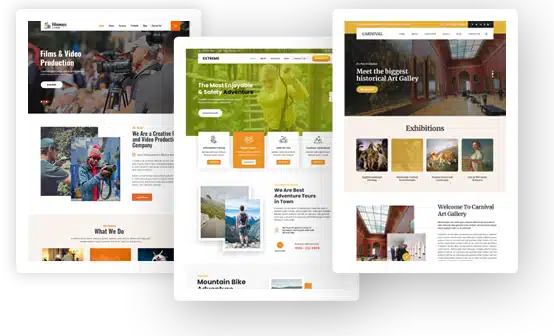Revamp Your Website: Unleashing The Web Developer’s Evolution

The internet’s dawn has fundamentally altered how we see and operate businesses. The ecosystem of business and commerce is evolving at lightning-fast speed. The engine behind this ever-evolving landscape is the community of web developers who, with their tireless labor and web design skills, come out with optimal solutions for the business’s needs. The new technologies and platforms are emerging constantly making it harder for web developers to keep up. The business’s website may become obsolete over time and thereby lack visitors which can severely hamper the prospects of business. The website may be calling for a complete revamp if it had not been improvised to the current times.
One can take advantage of the latest website design features and trends when revamping a website. If optimized properly, it can revolutionize the online presence of the business and improve the outcomes. Here in this blog, we will discuss the ways to uncover the developer within and revitalize the website.
Navigation Simplifying
An outdated site often has cluttered and complex navigation. The menu structure should be simplified and streamlined when revamping a website. Then low-value and redundant pages should be removed to reduce clutter. The pages need to be organized in a logical hierarchy that makes them flow naturally. User experience will be improved because it makes it easier for visitors to find information on the user-friendly website.
Also, make sure that navigation is optimized for mobile devices. Mobile optimization has become a must for every website. The website should be displayed properly on smartphones and tablets, so you need to test the navigation for the same purpose. The hamburger menu icon should be considered to hide navigation items on small screens.
Choosing a Responsive and Modern Layout
The fixed widths of the static website designs feel outdated when compared to responsive and flexible layouts. The strategy when revamping a website is to implement a responsive design. The responsive design will automatically adapt to fit tablet, desktop, and mobile displays.
The CSS media queries and fluid width/columns are used in a responsive layout to resize elements based on screen size. A good step is to use a responsive framework like Bootstrap and Foundation to speed up development. It improves mobile usability by eliminating horizontal scrolling.
The optimization for mobile should be done before layering in desktop layout enhancements as the mobile-first approach is a silver standard these days. The mobile-first design will make sure that the site works optimally on smartphones right out of the gate. The web design skills of the developer are severely tested in coming out with mobile optimized user friendly website.
Page Content Streamlining
Minimalism and simplicity are the hallmarks of web design these days. Too much usage of text and images will puzzle visitors therefore one should avoid overcrowded pages.
Patience should be maintained and time should be taken to streamline page content when revamping a website. Unnecessary words should be thoroughly pruned and removed. Large blocks of text should be split into scannable paragraphs with subheadings. The numbered list and bullet points should be used for easy skimming. A proper evaluation of every chart, image, and graphic should be undertaken and things that don’t add value should be removed.
The scalability is improved and your message is amplified with white and negative spaces. The urge to fill in every inch should be kept in control. Empty spaces and a clean background make important elements stand out.
Enhancing Visual Appeal
After the content is streamlined, attention should be diverted to visual aesthetics. A visually appealing website enhances user experience and instills confidence in visitors.
A thorough study of competitors’ websites should be undertaken to take note of interface elements and website design. Scrutiny of engaging graphics, fonts, color palettes, and layouts will open the field wide for experimentation as these visual inspirations act as a style guide for your redesign.
Refresh your logo and color scheme. Optimization of images will make them load faster. The site should be made more unique by implementing custom illustrations and graphic elements. One doesn’t need to overhaul everything to improve visual appeal. The small changes will also impact the visual appeal and can modernize the look.
Optimizing Conversion Paths
Though a revamp allows you to make changes to your visual brand, business goals must always remain in sight. Look comprehensively for ways to optimize conversion paths so that more visitors become customers.
Conversions are likely to occur through pages like product descriptions, service pages, or contact forms. Identify these key areas of concern. Strengthen your call to action and enhance these pages to boost conversions. Keep it easy for customers to find information they may need to make a purchasing decision.
Measure the results by testing different layouts, content, images, and calls to action. Optimization elements should be doubled down to improve conversion rates. Attention should be paid to navigation paths and please make sure key pages are easy to find.
Upgrading Technical Elements
Together with front-end changes, make your website revamp as a chance to also upgrade the technical backend and infrastructure. Performance and security are improved by migrating to a newer, faster web hosting platform.
A proper audit of any outdated systems and programs like WordPress or PHP should be undertaken to make it a more user-friendly website. Take advantage of speed and security enhancements by moving to the most recent versions. The website needs to follow Google’s latest algorithms therefore improving your SEO framework.
Revamping your website also comes with the opportunity to implement HTTPS/SSL if you haven’t already. SSL certificate will encrypt data and protect user privacy. Not only does it improve SEO rankings but also signals the visitors that your site is secure.
Refining and Monitoring Post-Launch
The revamped website doesn’t stop evolving even after launch. Monitoring sales activity and visitor behavior in the months after relaunching is a handy practice. To further optimize conversions, identify any weak points or opportunities.
Make it a habit of refining page content, calls to action, navigation, and layouts. Run tests to determine which version performs best. Analytics should be reviewed to see which pages attract attention and which don’t.
The task of any revamping step is to see that it continues to meet the needs of the audience therefore ongoing refinement does the job well. One should not miss out on the opportunities for incremental improvements post-launch.
Conclusion
It takes strategic planning and care to revamp an outdated website. However a successful revamp opens up the gate of huge potential for brands and businesses. One should use this evolution to connect with the audience and deliver experiences that turn visitors into customers. Take auditing of your current website seriously and craft a revamp roadmap focused on speed, simplicity, engagement, and conversions. The web developer community is growing stronger. One should tap into new web design skills, tools, and passion to unleash the inner web developer.

